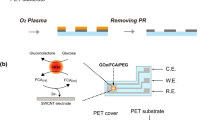Abstract
Penicillin G (Pen-G) biosensor was developed by immobilizing penicillinase enzymes (Pen-X) onto tiny bio-chips using thioglycolic acid self-assembled monolayer (TGA-SAM). The selective pen-G biosensor was investigated by ferri/ferrocyanide couple using electrochemical method for catalytic hydrolysis of Pen-G/Pen-X in a very sensible approach. Pen-G was detected with modified bio-chip (Gold electrode of bio-chip/Thioglycolic acid/Penicillinase enzyme, in shortly AuE/TGA/Pen-X) by reliable cyclic voltammetric method at pH 7.1 in room conditions. The AuE/TGA/Pen-X modified bio-chip sensor demonstrates good linearity (50.0 nM to 5.0 mM; R = 0.9987), low-detection limit (~1.26 nM, SNR ~ 3), and higher sensitivity (~4.97 μA.μM−1.cm−2), lowest-small sample volume (<70.0 μL), good stability, selectivity, and reproducibility. To the best of our knowledge, this is the first statement in which such a very high sensitivity, low-detection limit, and low-sample volume are required for Pen-G biosensor using AuE/TGA/Pen-X bio-chips assembly. The results of these studies have introduced for biomedical applications with interesting assembly (AuE/TGA/Pen-X) towards the development of selective Pen-G biosensors. The AuE/TGA-SAM system was implemented a facile approach to the integration of Pen-X/Pen-G fabricated bio-chips, which can offer analytical access to a large group of enzymes for wide range of biomedical applications in health-care fields.






Similar content being viewed by others
References
E.P. Abraham, E. Chain, Nature 146, 837 (1940)
S. Caras, J. Janata, Anal. Chem. 52, 1935–1937 (1980)
S. Caras, J. Janata, Anal. Chem. 57, 1917–1925 (1985)
B. Chen, M. Ma, X. Su, Anal. Chim. Acta. 674, 89–95 (2010)
M. Gamella, S. Campuzano, F. Conzuelo, M. Esteban-Torres, B. de las Rivas, A.J. Reviejo, R. Munoz, J.M. Pingarron, Analyst 138, 2013–2022 (2013)
L.M. Gonçalves, W.F.A. Callera, M.D.P.T. Sotomayor, P.R. Bueno, Electrochem. Commun. 38, 131–133 (2014)
E. Gustavsson, P. Bjurling, Å. Sternesjö, Anal. Chim. Acta. 468, 153–159 (2002)
D. Hafeman, J. Parce, H. McConnell, Science 240, 1182–1185 (1988)
W.M. Hassen, A. Abdelghani, L. Vonna, K. Cherif, M. Boussaid, M.A. Maaref, Sens. Actuator. B 120, 621–627 (2007)
B.G. Healey, D.R. Walt, Anal. Chem. 67, 4471–4476 (1995)
Z.H. Ibupoto, S.M.U. Ali, K. Khun, C.O. Chey, O. Nur, M. Willander, Biogeosciences 1, 153–163 (2011)
S. Kumaran, H. Meier, A.M. Danna, C. Tran-Minh, Anal. Chem. 63, 1914–1918 (1991)
S.R. Lee, M.M. Rahman, M. Ishida, K. Sawada, Trends Anal Chem 28, 196–203 (2009a)
S.R. Lee, M.M. Rahman, K. Sawada, M. Ishida, Biosens. Bioelectron. 24, 1877–1882 (2009b)
H. Meier, F. Lantreibecq, C. Tran-Minh, J. Autom. Chem 14, 137–143 (1992)
M. Nishizawa, T. Matsue, I. Uchida, Anal. Chem. 64, 2642–2644 (1992)
T. Osa, Appl. Biochem. Biotechnol. 41, 41–49 (1993)
M.I. Pividori, A. Merkoci, S. Alegret, Analyst 126, 1551–1557 (2001)
A. Poghossian, J.W. Schultze, M.J. Schoning, Sens. Actuator B 91, 83–91 (2003)
M.M. Rahman, Inter. J. Biol. Med. Res. 1, 9–14 (2010)
M.M. Rahman, J. Biomed. Nanotechnol. 7, 351–357 (2011)
M.M. Rahman, A. Umar, K. Sawada, Adv. Sci. Lett. 2, 28–34 (2009)
M.M. Rahman, A. Jamal, S.B. Khan, M. Faisal, ACS App. Mater. Interf. 3, 1346–1351 (2011a)
M.M. Rahman, A. Jamal, S.B. Khan, M. Faisal, J. Phys. Chem. C 115, 9503–9510 (2011b)
M.M. Rahman, A. Jamal, S.B. Khan, M. Faisal, Biosens. Bioelectron. 28, 127–134 (2011c)
J.F. Rusling, Anal. Chem. 48, 1211–1215 (1976)
J.F. Rusling, G.H. Luttrell, L.F. Cullen, G.J. Papariello, Anal. Chem. 48, 1211–1215 (1976)
K. Sawada, S. Mimura, K. Tomita, T. Nakanishi, H. Tanabe, M. Ishida, IEEE Trans. ED 46, 1846–1849 (1999)
K. Sawada, T. Shimada, T. Ohshina, H. Takao, M. Ishida, Sens. Actuator B 98, 69–72 (2004)
B.H.V. Schoot, P. Bergveld, Biosensors 3, 161–186 (1987)
A. Seki, S. Ikeda, I. Kubo, I. Karube, Anal. Chim. Acta. 379, 9–13 (1998)
J.R. Siqueira Jr., M.H. Abouzar, A. Poghossian, V. Zucolotto, O.N. Oliveira Jr., M.J. Schöning, Biosens. Bioelectron. 25, 497–501 (2009)
M. Stred’anský, A. Pizzariello, S. Stred’anská, S. Miertuš, Anal. Chim. Acta. 415, 151–157 (2000)
X. Xie, A.A. Suleiman, G.G. Guilbault, Biotechnol. Bioeng. 39, 1147–1150 (1992)
Acknowledgments
Author is thankful to Center of Excellence for Advanced Materials Research (CEAMR) and Chemistry department, King Abdulaziz University, Saudi Arabia. Toyohashi University of Technology, Japan is also highly acknowledged for fabrication of tiny bio-chips.
Author information
Authors and Affiliations
Corresponding author
Electronic supplementary material
Below is the link to the electronic supplementary material.
ESM 1
(DOCX 34 kb)
Rights and permissions
About this article
Cite this article
Rahman, M.M., Asiri, A.M. Development of Penicillin G biosensor based on Penicillinase enzymes immobilized onto bio-chips. Biomed Microdevices 17, 9 (2015). https://doi.org/10.1007/s10544-014-9910-0
Published:
DOI: https://doi.org/10.1007/s10544-014-9910-0




